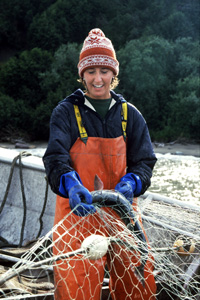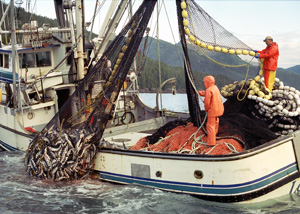Wild Salmon vs. Farmed Salmon |

A commercial salmon fisherman picks wild salmon from her gill-net. American consumers are increasingly concerned about the source of the food products they buy. Whether it's organic carrots, free-range chicken, or range-fed beef, we all take into account the source of the food we eat for reasons concerning our environment and the health benefits of the food itself. However, many consumers looking for healthy meal options wouldn't think twice about heading to the supermarket and picking out a piece of farm raised salmon for dinner. What is wrong with "farmed" or Atlantic Salmon you might ask? The answers may surprise you... Farm-raised fish are confined to saltwater net-pens, unlike their wild counterparts who swim long distances building healthy lean muscle fiber along the way. Because of their sednetary lifestyle, farmed salmon pack up to three times more saturated fat! Wild Salmon are subject to the rigors of life at sea - as part of the natural food chain where only the healthy and strong survive. Farmed fish spend their lives in large sea-water cages where the survival rate is comparably very high and natural selection to cull the weak does not exist. Therefore, when comparing the fillets of wild salmon and farmed salmon, side-by-side, the flesh of wild-caught salmon tends to be more firm and evenly textured. Farmed salmon consume "fish pellets" or food that is often high in unhealthy components such as PCB's and Mercury. These unhealthy ingredients build up in the fatty deposits of the farm raised salmon. While these components aren't normally viewed as reaching "unhealthy" levels, wild salmon, by comparison, have far lower concentrations. Wild fish eat plankton, krill, and small fish which are naturally high in Omega 3's. These small feed fish are also what naturally gives wild salmon its beautiful reddish-orange color - coloring that is added as a food supplement for farm raised fish. Omega 3 fatty acids are one of the key building blocks for healthy human cellular development and are one of the main reasons that consumption of wild salmon has so many positive effects on the body. Omega 3's perform a critical role in healthy brain function boosting memory and cognitive performance. They reduce inflammation which has positive effects on the heart and circulatory system, and they've been found to reduce pain. High intake of Omega 3's has been shown to have positive effects on early childhood development, as well as easing symptoms of depression and rheumatoid arthritis. As you can see, consuming Omega 3 fatty acids through natural sources such as wild salmon has many proven benefits. 
Fishermen on a purse-seine vessel pull a net full of wild Alaskan salmon. Perhaps the most compelling reason to select wild salmon vs. farmed salmon centers around the protection of natural salmon runs and the impact that large salmon rearing operations can have on the environment. Because farmed fish are kept so tightly corralled, the potential for breeding salmon parasites and infectious disease is very high. Evidence from these operations shows the incidence of sea lice infestations, kudoa (mushy-flesh), and infectious salmon anaemia in farmed fish has ballooned as salmon farms have expanded. In one study, sea lice concentrations at a Canadian salmon farm were found to be 30,000 times above normal. Unlike the fish that host them, tiny sea-lice are not confined by the net-pens. This in turn threatens wild salmon stocks nearby as they attack and kill juvenile salmon. Each year many thousand salmon escape from fish farms. These fish mix with wild stocks and, contrary to what was once thought, have been found colonizing natural spawning streams, reducing the viability of wild runs. This has the potential to cause irreparable harm to wild salmon stocks throughout the West Coast of the US, Canada, and Alaska. So, next time you crave a healthy salmon meal, make sure you choose wild-caught salmon from Alaska... Don't Just Take our Word! - Additional Resources on Selecting Healty Salmon:Wild Salmon vs. Farmed Salmon - Prevention Magazine Alaska Salmon - Marine Stewardship Council What's New and Beneficial about Salmon Alaska Dept. Fish & Game - Salmon |
Alaska Fishing Charters
Captain Jack's is located on the docks in Seward, Alaska. Having a first-hand look at each catch, we know which Seward fishing charters routinely find the fish. We can point you in the right direction to tip the scales in your favor.
Share Your Recipe
Share your favorite seafood recipes with us and earn 500 JACKpot Reward Points for each one!

Our Fish Fly First Class
Captain Jack's Seafood Locker ships your freshly-frozen Alaska Seafood via UPS overnight delivery, directly from our freezer to your front door. This ensures that when you order Alaskan seafood from Captain Jack's it arrives in perfect condition on the day you choose.
Pardon our website, we are currently working on updates! Captain Jack's is currently shipping with UPS to get your product to you in the best condition, the fastest way possible. For any questions on shipping, please call 907-224-8082.



